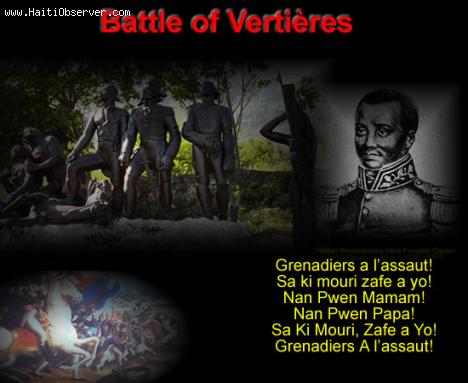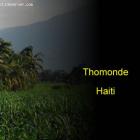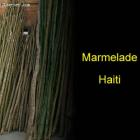ADVERTISEMENT
Vertieres - Haiti Observer Blog
Vertieres, Haiti Observer Blog. Read the following articles about Vertieres
Haiti is now in a Battle similar to the one fought in Vertieres in 1803
As the political crisis continues in Haiti between President Michel Martelly and the various groups in opposition, the two sides seem to get ready for a major fight. As far a I am concerned, they are heading straight to a total destruction, the ultimate battle, just like the one conducted by the forces of freedom during the colonization period in Saint-Domingue which was called the Battle of Vertières.
The Battle of Vertières took place less than two months before Haiti Proclamation of Independent. Probably one of the most important battles in the Haitian revolution, the battle of Vertières was between the expeditionary forces of the French and the Haitian rebels. Fought on November 18, 1803, the battle would be the second major one of the Second War of Haitian Independence, as well as the last part of the François Capois-led portion of the Haitian revolution.
Vertierre or Vertieres, Pivotal in Haiti Independence
Saint Domingue on island of Hispaniola was once the most lucrative part of French colony on the Caribbean island from 1659 to 1809. But a slave revolt in which the battle of Vertierre or Vertieres was pivotal ended the colonization. With support of British government ended the French rule in Saint Domingue and the French were forced to withdraw themselves from this European colony in 1803.
The decisive encounter between General Rochambeau of the French army and the separatist British supported leader General Jean-Jacques Dessalines is known as 'War of Vertières'. General Dessalines who was born as a slave led the struggle against the French. The British weakened the French by naval blockades and supplied weapons and ammunitions to General Dessalines. Sensing danger, Rochambeau shifted French headquarters from Port-au-Prince to Cap Français. Dessalines went on capturing places one after another like Jacmel, Cayes, Jérémie and Léogane. When the French Commander surrendered himself on October 3 at Port-au-Prince, stage for physical attack was set on Le Cap Français.
The Battle Of Vertieres
The battle of Vertieres near Cap-Haitian was motivated by slaves who hat the condition under which they have been living.
Napoleon was confident that slavery would be reestablished in Saint-Domingue. General Rochambeau, who succeeded Leclerc as commander of the French army in Saint-Domingue, started implementing a series of atrocities including mass hangings and drowning of slaves suspected to be involved in insurrections.
Dessalines relentlessly attacks one town after another. He started in the South of the Country with Cayes, then Jacmel, Léogane, Jérémie, Saint Marc and Port-au-Prince. These actually set the stage for the assault on le Cap Français in the last great battle of independence in Vertieres.
The Famous "Grenadiers a l'assaut" Statement
Haitian historians reported that on November 18th, 1803, the last battle of the Expedition Santo Domingo with the slaves of the colony took place in Vertières near Cap-Francais known today as cap-Haitian or Cap-Haitien.
The troop commanded by General Rochambeau for the French Colonizer went head to head with the troop of General Jean-Jacques Dessalines, leader of the slave rebellion.
General François Capois, known as Capois-la-Mort led his brigade forward toward the forts of Vertieres under a storms of bullets from the forts
As he was approaching to Charrier, French fire killed a number of soldiers in the Haitian column. The Haitian soldiers closed ranks with great determination to win the battle, singing:
General Francois Capois, Capoix-la-Mort, and the Battle Of Vertieres
In the Battle of Vertieres near Cap-Haitian which is considered to be the decisive battle that eventually earned Haiti its independence, General Francois Capois, Capoix-la-Mort, occupied a key position in it.
Historians tell us that on November 18th, 1803, the leader of the Haitian rebels Jean-Jacques Dessalines ordered Capois lamort Brigade to take Fort Vertières, Capois raised several unsuccessful attempts until
Capoix, mounted on his great horse, led his brigade forward despite storms of bullets from the forts. As he is approaching Charrier, his horse was hit by a cannon and fell. However, Capois picked himself up, took his sword, stood up and ran again to the head of his soldiers shouting always "Forward! Forward".
Vertieres, Near Cap-Haitian, Site of Last Battle Before Haiti independence
This was the last battle of the Expedition Santo Domingo. The battle took place in Vertières Vertières near Cap Francais, now known as Cap-Haitian. It involves a troop commanded by General Rochambeau for the French Colonizer and General Jean-Jacques Dessalines, leader of the slave rebellion.
On November 18, 1803 , Jean-Jacques Dessalines ordered François Capois (Capois lamort) Brigade to take Fort Vertières, located on a hill near the city of Cap-Haitian. Capois raised several unsuccessful attempts by had to go back due to heavy fire from the fort.
After the third attempts where many of his forces received many casualties, Capois-La-Mort asked his force to follow him, shouting: "Forward! Forward". At one point, his horse was hit by a cannon and fell, but Capois took his sword, stood up and ran again to the head of his soldiers shouting always "Forward! Forward".
Cap-Haitian, A Fine Vacation Destination In Haiti
Cap-Haitian also known formerly as le Cap, Cap-Henri and Cap-Francais is located on Haiti's northern coast. It is the capital of the Department of Nord and is located near Milot, a historic town. It has around 190,000 inhabitants with indigenous migrants from South and Central America. During the colonial rule it was an important city where it served as the capital of the French Colony of Saint Dominigue from 1711 to 1770.
Anti Government And Revolutionary Movements
The capital was moved to Port-au-Prince. Initially, under the rule of King Henri Christophe, it was Kingdom of Northern Haiti's first capital. Infrastructure for transportation was not very good during that time. The city was destroyed by the 7th May 1842 earthquake.
Our objective is to share with you news and information about Haiti and the people of Haiti. Traditions, habits and the way we were or grew are alive in this site. We highly recommend that you Subscribe to our Newsletter and also share with us some of the things that are memorable and made us unique people.


 Thomonde, Haiti
Thomonde, Haiti  Something to think about
Something to think about  La Chapelle, Haiti
La Chapelle, Haiti  Maissade, Haiti
Maissade, Haiti  Marmelade, Haiti
Marmelade, Haiti